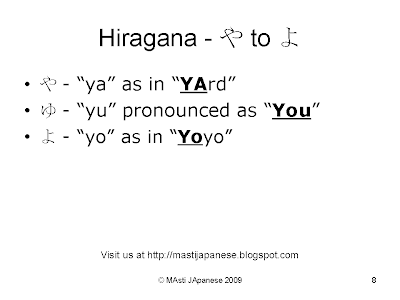Every language needs a script for it's written form. Japanese is not an exception! To write in Japanese, two different scripts can be used namely Kana and Kanji. This Kana is further sub divided into Hiragana and Katakana. Kanji is the script that was inherited from Chinese centuries ago.
Hiragana & Katakana - Why two?
It's enough to learn just 26 letters to master English Script (also called as the English Alphabets). When it comes to Japanese, there are about 46 letters both in Hiragana and Katakana. Combination of two kanas can produce a new sound which we will see in our lessons. You should know that the letters both in Hiragana and Katakana share the same pronunciations.
If they have the same pronunciations then why two different scrips? Well it's not only you but any person starting to learn Japanese will wonder why should Japanese have two different kanas. Well, the reason is clear and simple. To justify, let me tell you some example -
How do you write the word 'Determination' in English?
Determination - yes, you will write it as it is because the word Determination is an English word.
Now, let's consider a non-English word. Say, नमश्कार. This is a Hindi language word which translates to Welcome in English). So, now how do you write this word in English? You will transliterate, yeah? Hence it will be Namashkaar!
This same rule applies to Japanese as well with a little twist. Unlike English which uses same script for both English and foreign words, Japanese use Hiragana to write Japanese words and Katakana to write foreign words.
Example:
The word Nihon (meaning Japan) is a Japanese word so it should be written in Hiragana where as this site name, MaJa is a non-japanese word and hence it should be written in Katakana.
Note: As we move down the lessons, you will also find that Japanese words that can be written using Hiragana can also be written using Kanji's.Kanji? Say what?Kanji are the symbolic representations of a word i.e., pictogram! As said earlier, these script are inherited from Chinese over centuries. Kanjis have different readings (pronounciations) and meanings depending on how they're combined with other kanji. As everyone else say, it is not really that hard to learn Kanji as long as you practise. However it is really challenging to remember their stroke order. Don't get confused with the word stroke order. It just means the sequencial order in which a Kanji should be written.
Japanese FAQ claims that there are about 50,000 Kanji but you need not learn them all! Think that you are fluent enough in English. Does that mean you know all the letter in English? Not really! The same logic holds good here. To understand, write and speak Japanese fluently, it is more than enough if you know about 1,000 Kanji. It is said that the Japanese Ministry of Education declared 1,945 characters as "
Jooyoo Kanji", which are the most frequently used characters.
When it comes to the
Japanese Language Proficiency Test, they require you to know some amount of Kanji's depending on your JLPT level as shown below:
Level 4 - Around 100 Kanji
Level 3 - Around 300 Kanji
Level 2 - Around 1,000 Kanji
Level 1 - Around 2,000 Kanji
However, if you are beginner you should first be starting it with Hiragana, Katakana and then Kanji parallely learning vocabularies. That is how I started mine :)



























